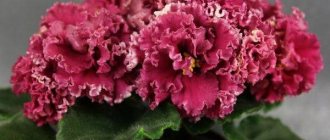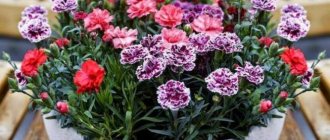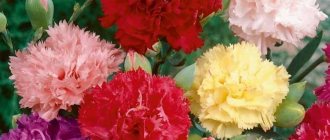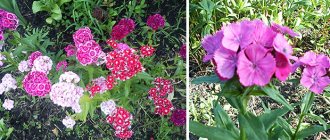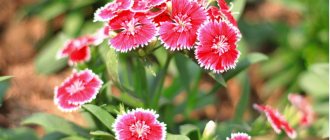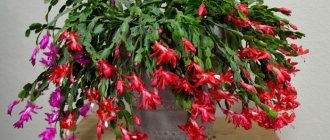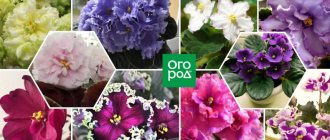Dianthus deltoides or Dianthus grass is a perennial shrub belonging to the Dianthus family. Under natural conditions and in cultivated form, it is found everywhere in the north of the Eurasian continent.
Author of the article
Maxim Sverchkov
Professional biologist and breeder with extensive experience and experience.
All of Europe, the territory of our country up to Siberia and even the north of India is inhabited by this plant. It chooses the edges and meadows of forests, clearings, hillsides, and river banks as its habitat, preferring suboceanic climatic conditions.
Description and features of the type of carnation Travyanka
Flowers are characteristic of carnation plants - they gradually expand from the base to the jagged edges. The capsule where the seeds are formed is located between the petals. This type of plant easily takes root on slopes and elevated surfaces due to the structural features of the root system. The grass grows in all directions, which makes it possible to stay on soils of this type. It is found in India, in Europe, and can also be seen near rivers and in the steppes.
The advantage is that the plant is quite resistant to disease, but sometimes young bushes suffer from insects and rodents.
Varieties of cloves Travyanka: characteristics of varieties
The table presents data describing the characteristics of each type of Carnation grass:
| View | Height, cm | Description | Flowers, flowering period |
| Wild growing | |||
| European | 20-40. | The leaves are dark green in color. Lifespan is approximately 6-9 years. Tolerates low temperatures down to -40 °C. Reproduction method: seeds and layering. Resistant to pests and diseases. | Five petals that grow from the beginning, the edges have a jagged shape. The color is red, hot pink and purple. Flowers, in the center of which many seeds are formed, are always collected in inflorescences. |
| Siberian | |||
| Indian | |||
| Breeding | |||
| Diamond | Approximately 15. | It has a pillow shape. Fast growing plant. The leaves are oblong, narrow, dark green in color, and have a white coating. Loves open, moderately moist, sunny places. This variety of carnation grass is resistant to temperatures down to -35 °C. | The flowers are cherry red. Mid-June – early October. |
| Toronto | Compact bush up to 15. | Prefers non-acidic soils, does not tolerate very wet places. The ideal temperature for seed germination is +14…+15 °C. Not resistant to cold weather. Removing faded flowers has a beneficial effect on further growth. | Five white feathery petals smoothly expand from the middle to the outer part of the flower; inside there is a crimson-red rim, which is characteristic of some varieties of Carnation grass. June August. |
| Variegated lawn | Around 17. | The ideal temperature for good growth is +15…+19 °C. The soil is non-acidic, drained, in which water does not stagnate for a long time, but flows out through the holes in the pot. | The color is white, pink and red. June August. |
| Allegory | 20-25. | One of the perennial species of Carnation grass. It has gnarled stems that often branch at the top. Almost the entire part of the plant is covered with plaque. They are grown by sowing in open ground, after the 7th day the first seedlings are already observed. | Carmine-red flowers 1.0-1.5 cm in diameter. June - August, after which it is recommended to cut off the flower stalks. |
| Flashing light | 40. | The entire length of the stems, like the leaves, are covered with small hairs. Prefers loamy garden soil containing clay and sand in its composition. | The petals are sharp-toothed and dark pink. June – September. |
| Canta libra | Low - from 10 to 15. | Fast breeding. Resistant to sub-zero temperatures. Grows well in sandy, moderately moist soils. | Graceful and large flowers of dark red shades. Beginning of June – end of September. |
| Sparkle | Up to 25. | An unpretentious plant that grows well in open areas with plenty of light. The leaves are narrow, covered with a gray coating. | Flowers are soft pink. Does not require special care Mid-July - end of September. |
| Arctic Fire | 20-25. | Age - one year. The plant is light-loving, drought-resistant, and tolerates severe frosts well. Quite often, this variety of Carnation grass is used in landscape design, planted under coniferous trees. | The flowers are large and have a pleasant aroma. Color: white and red June and September. |
| Dolly doll | 18-20. | Annual variety. Cold-resistant plant, prefers sunny areas and non-acidic soils. | The diameter of the white-red flowers is 4–6 cm. July – early October. |
Description
The plant is a low herbaceous bush with a short but widely branched root system.
The slightly pubescent, rigid stems are divided into two types. Vegetative ones, or those that do not produce flowers, reach a height of up to twenty centimeters and bear abundant foliage. Flowering shoots are longer, up to forty centimeters, branch at the top into two or three parts and are crowned with flowers.
Leaves of narrow and long shape are basal and stem. The first ones are larger, the second ones are smaller, up to three millimeters wide, and have jagged edges. As they grow, their color changes from bluish-green to bright green.
Five-petalled flowers can have bright red, pink, white colors, and even a mixture of them. They form small inflorescences, growing at the tops of the branching parts of the flowering shoot. The size of the flowers reaches two centimeters in diameter.
Some flowers have pedicels up to three centimeters long. The edges of the petals are smooth or finely jagged. A distinctive feature of the species is the presence of a calyx at the base of the petals. For carnation grass, the flowering period begins in mid-summer and lasts on average forty-five days, until the beginning of autumn.
At the end of the flowering period, a fruit appears on the plant, which is a small box with a large number of very small seeds.
After ripening, the capsule bursts, allowing the bush to reproduce well by self-seeding.
Features of caring for Travyanka
Caring for the plant is not burdensome or difficult. Considering the fact that carnation grass is quite unpretentious, it is important that the flower does not grow in waterlogged soil (otherwise the roots will begin to rot, and this, in turn, will develop fungal diseases). It is also very important to apply phosphorus, magnesium, nitrogen and calcium fertilizers depending on the time of year.
Application
In medicine: An infusion of the herb is used as an anti-inflammatory, antipyretic, diaphoretic, antispasmodic, antibacterial, hemostatic and analgesic, expectorant, sedative, anticonvulsant, antitoxic, diuretic and astringent.
Used for uterine (including postpartum), internal and hemorrhoidal bleeding, in proctology, for allergies and rheumatism, stomach diseases, pain in the heart, palpitations, kidney diseases, bladder, edema, scrofulosis, headaches and migraines, to reduce pressure, for convulsions and to relieve attacks of epilepsy, for nausea or vomiting. Cloves increase the tone of the uterine muscles. Due to this, it can be used against uterine atony and postpartum hemorrhage.
Clove tea is drunk to relieve asthma attacks and severe coughs during flu and colds. Externally make poultices, lotions and compresses from clove infusion for phlegmon, erysipelas, rheumatism and radiculitis, other diseases of the joints, muscles, bruises; Wash wounds and ulcers with the infusion, wipe the face for pimples and acne.
In other areas: Carnation grass is used as an ornamental plant, unpretentious, blooming for a long time and abundantly. It looks impressive when planted in separate groups, as a ground cover or border plant, in rock gardens. An infusion of herbal cloves is used in veterinary medicine. Honey plant.
Planting carnations Travyanka
Planting is one of the most important stages in the process of growing a flower. Despite the fact that most varieties of Carnation grass are perennial plants for open ground and do not require special care (Allegory is an example of such a variety), it must be replanted every 3-4 years.
This is necessary in order to preserve the decorative properties of the flower, namely the presentable appearance of the plant, since the bush grows chaotically and the decorative role disappears.
This plant loves dry, non-acidic soils. Before planting, the soil should be cleared of weeds, and the seedlings should be soaked in a chemical solution that protects against pests and diseases. If the gardener decides to plant Carnation grass in watery soil, it is worth adding limestone and sand.
Summary
Carnation-grass: video
Carnation grass dianthus deltoides red is simply a stunning perennial that has incredibly attractive decorative properties. Very few species of other plants can compete with them, since carnation is an unpretentious, frost-resistant and colorful plant that produces lush shrubs dotted with flowers. They look great both in single plantings and in group compositions. Thanks to so many benefits, the carnation remains an incredibly attractive and significant plant, and will probably remain so for many years to come.
Growing Grass from seeds and seedlings
Annual and biennial varieties are grown from seeds. Since the plant is frost-resistant, the seeds can be planted before winter, as a result of which the grass will sprout in mid-March. If we are talking about sowing in the warm season - the period from April to the end of May. Carnations will absolutely take root only in loose soil on a slight elevation - this is due to the fact that water never stagnates in soils of this kind, and this has a very beneficial effect on the life of the plant.
When planting Carnation grass, you should consider some of the disadvantages of growing from seeds:
- The seed size is too small to ensure uniform sowing.
- In the spring, due to constant temperature changes, weeds grow very quickly and absorb everything they need from the soil for growth.
Grass seedlings are very fragile and delicate, so under no circumstances should they be planted during frosts - the bushes simply will not survive. Typically, seedlings are planted in long ditches or holes.
It is recommended to plant seedlings in groups of 6-8 in open ground. The distance between them should be from 15 to 30 cm.
Kinds
The plant has been cultivated by flower growers for centuries. During this time, many varieties of grass carnation have appeared, some of which are especially decorative and unpretentious. Here are just a few of them.
Shabo
A perennial bush with double inflorescences consisting of large flowers of different colors. It is distinguished by original flowers, the petals of which form unusually shaped buds with wavy edges, as well as a wonderful smell.
Dutch garden
A perennial hybrid with a very long flowering period, beginning in mid-summer and ending in late autumn.
Cirrus
A perennial small, compact, but dense bush with double flowers of different colors. The flowering period continues throughout the summer.
Turkish
Unpretentious perennial bushes with inflorescences consisting of large flowers.
It will be interesting to read about Ifeyon: cultivation features and varieties.
Vegetative propagation of a plant
Dividing a bush is one of the types of propagation of Carnation grass. The flower grows, exposing the center, after which it must be dug up and divided into small bushes. The next action that will provide good conditions for Carnation grass is placing the seedlings in the ground, in their further habitat. They do not require special care; you just need to water and loosen the soil around the bushes, enriching the soil with oxygen.
Rules for planting a cute flower
Having examined the most popular varieties of carnations, you will notice that this flower is widely used to decorate summer cottages. But, despite the sophistication of the cultivated species of this plant, wild varieties are valued no less. Among them are carnation grass and garden carnation. By growing these varieties in the front garden at the dacha, you can add notes of pristine nature to your mini landscape.
Planting and caring for perennial grass carnation, a photo of which helps to see it in all its glory, includes the following work:
- sowing seeds;
- cutting method;
- timely watering:
- fertilizing the soil.
Before sowing wild carnation seeds, it is important to prepare the soil. To do this, it is disinfected with special means to kill possible pests in it.
Then sand is added to the soil, mixed and small containers are filled. After this, you can sow cloves. It is better to keep the pots in a warm room at a temperature of at least 16 degrees. When the sprouts rise and get stronger, they are planted in a permanent place in the country landscape.
Planting carnation grass using the cutting method involves the following techniques:
- cuttings;
- propagation by layering;
- dividing bushes.
Cuttings begin to be carried out at the beginning of summer, selecting suitable plants. They should be up to 10 cm long. A cut is made at an angle, the lower leaf plates are removed and the cutting is placed in a container with soil. After abundant watering, the container is covered with film or agrofibre. When the seedling gets stronger, it is planted on the site.
The method of planting carnation grass using layering is not often used, because this requires very long plant stems. If there are any, an incision is made into the internode and buried with soil. As a result of abundant watering, the cuttings will grow roots. Now it can be dug up and planted in a new area.
Dividing a grass carnation bush is perhaps the most optimal option for planting a plant. This method is quite simple: a part of the bush is split off and planted in a new territory. Abundant watering and carnations are already growing in the front garden.
Since carnation grass is an unpretentious plant, it is enough to provide it with timely watering and regular fertilizing of the soil. The main condition is to control the humidity so that the roots of the cloves do not rot.
Planting and caring for perennial garden carnations is carried out in a similar way. In order for the plant to bloom as long as possible in a summer cottage, it is better to plant it in sunny places. Timely feeding and regular watering will ensure comfortable prosperity for the plant throughout the season. In addition, it is advisable to remove faded buds from the shoots to allow the plant to take root. In winter, garden carnations are covered, especially if there is little snow in the region.
Then the red carnation, a symbol of kindness and true love, will always flourish in the landscape design of the dacha.
Disease and pest control
| Disease/pest | Manifestations | Corrective measures |
| Alternaria blight | Formation of brown spots and dark green coating on leaves and stems. | The plant dies because this disease cannot be treated. |
| Fusarium | Brown color on the stem. Yellow spots appear on the leaves, as a result of which they begin to dry out. | It is recommended to pour lime into the hole. It is worth considering that the plant will be saved, but the flowers will no longer bloom on it. |
| Rust | Red-brown swellings on the leaves. | The affected parts must be cut off, and then the Carnation grass must be treated with fungicides (chemicals to combat fungal diseases). |
| Thrips, mole crickets | Deformation of leaves, appearance of brown or brown spots. | Areas that are too damaged must be cut off. Change the top layer of soil, as thrips larvae may be present there. The next step in rescue is spraying the plant with chemicals. |
| May beetle, cutworm, rodents | Eaten marks on the leaves and stems of the plant. | In cases where the Carnation herb has suffered minor damage, treat it with fungicides. If the plant is damaged by more than 50%, it will not be possible to save it. |
How to collect seeds
A gardener caring for flower beds from time to time clears the flower garden of dried, yellowed leaves and wilted petals, and leaves the required number of flowers to collect seeds. In order to collect the seeds of your favorite variety of grass carnation, you need to select large and healthy flowers in advance. By the time the seeds are collected, the flower box should turn yellowish, beige or brown (the color depends on the type of grass). The petals should be completely dry by this time.
It is not difficult to obtain quality seeds. But you need to remember that if the boxes are collected early, the seeds will not ripen and will not sprout next year. If the grower does not collect the boxes on time, the seeds will fall into the ground, where they are simply not visible (if the winter is warm enough, they will self-sow next spring).
Collecting clove seeds
Important! It must be remembered that if there are long autumn rains, then the ripened seeds must be removed in time. Too much water can cause flowers to rot.
The boxes are cut with scissors, placing a cup or container. The crop is then dried for several weeks, the seeds are removed from the pods, placed in a paper bag and stored in a dark place. Seeds should not be stored at sub-zero temperatures. Temperatures above +10-12 degrees can lead to drying out and death of the seed. The room should not be too humid - in this case, mold or mildew may appear on the seeds.
Seeds
